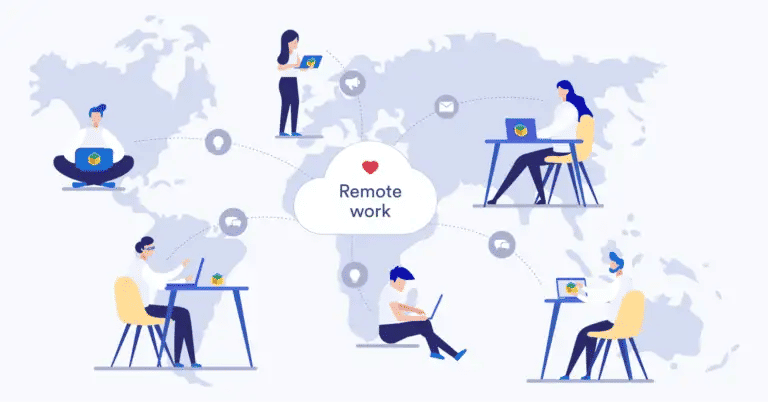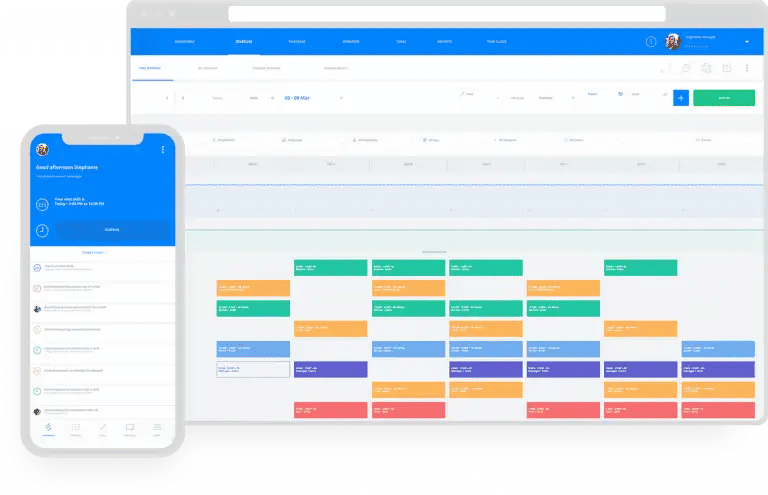Scheduling Software: The Best Digital Tools to Manage Remote Teams Successfully

Since the introduction of the global pandemic of COVID-19, the term “work from home” become insanely popular. Another phenomenon that entailed this new normal was remote teams– a concept where professionals working in the same company or even affiliated with different organizations come together and collaborate to complete a specific project. This was made possible with the help of advanced technology and digital tools, such as video assistance, augmented reality, and so on. No matter how novel and cutting edge it may sound, this has been a common practice in field service management.
Ready to get started with Field Promax?
Sign Up FreeTo elaborate, field service has always relied on remote teams. So, this is nothing new in this particular sector. However, with the proliferation of remote collaboration across the business environment, field service has also benefitted from the latest technology and digital tools developed to boost remote team management. Among the variety of software solutions that garnered noticeable popularity in this sector lately, appointment scheduling software has perhaps been the most important and beneficial of them all.
If you run a service business, you are more than aware of the importance of efficient scheduling and dispatching of remote teams. However, there is more to the story. So, keep reading to learn more about scheduling software, why it is important for remote team management, how it works, and most importantly, why you need to invest in this cutting-edge technology.
1. The Challenges in Managing Remote Teams

Managing remote teams always entails a host of unique challenges. But when it comes to field service, the stakes are even higher. Let us take a look at what challenges field service workers face while working remotely.
- Communication: This is perhaps the most crucial aspect of collaboration. It is hard to achieve a goal unless the team members are all on the same page about the vision, expectations, and guidelines. But unlike a regular office environment, one cannot just gather the employees around in a conference room at the beginning of the day and share necessary information to get the job done. The lack of spontaneous face-to-face engagement could be detrimental to successful remote collaboration.
- Tracking Equipment: Field service often requires specilized tools and equipment. And they are often quite expensive. If a single item is misplaced, it will not only cost the company a fortune, but it will also be difficult to get the job done on time. But when working with remote teams, it is not possible for one person to keep track of all the items, parts, and tools being carried to the job site.
- Training and Supervision: More than the right tools and parts, successful completion of field service tasks demands expert skills. To this end, you need to ensure that all your employees are properly trained and are following the standard mode of operation. Even if you send your best employees to the job, you might worry that they are not working as efficiently as they should due to the distance. On the other hand, employees may also struggle with less or no access to managerial support, which may in turn affect the quality of the work.
- Team Cohesion and Organizational Culture: Most companies have a strong vision, mission, and standard of how they operate in the field. When employees work together in an office environment, it is easier to instill this ethos in them and build a solid organizational culture. However, spreading your company culture could be an uphill task when people are collaborating remotely.
- Scheduling and Dispatching: the most important, and perhaps the most challenging task in field service is scheduling and dispatching technicians. Every job order is different and they demand unique sets of skills and experiences. However, when you are managing a remote team, this could be an even bigger challenge. You don’t have your employees around to have a look and determine who to send for the job. Neither do you have their schedule to know of they are available when needed.
Want a personalized demo?
See how Field Promax can transform your field operations
2. The Advantages of Using Digital Tools to Facilitate Effective Remote Collaboration

Considering the challenges in managing remote teams in field service companies, it is evident that you need a strong management system and strategy if you want to facilitate effective remote collaboration. But if you are doing things the usual way, using the same old pen, paper, and excel sheets, things will be more difficult. Not only manual methods are more complex and hard to organize, it also leaves more room for errors and mismanagement. But with the advent of modern technology, things have become quite the cakewalk. And as mentioned earlier, innovative digital tools have become the cornerstone of successful remote collaboration. This is how they can help you overcome the challenges.
Improve communication: The biggest challenge in remote team collaboration. As we have discussed earlier, is lack of communication. But if you have the right applications or mobile technology, connecting with your field employees is a matter of a moment. As long as you provide a two-way communication channel for your field workers, they will always have access to necessary information, communicate with each other to successfully collaborate, and provide feedback on time. On the other hand, you will also have direct contact with them around the clock to be on top of your operations, no matter where you are.
Increase transparency and scalability: The biggest advantage using digital tools in remote collaboration is enabling real-time tracking and monitoring of the processes. With time-tracking, GPS, and other monitoring tools, you can track your employees, equipment, inventory, vehicles, and all other resources being utilized in the field. This helps immensely in supervising projects and monitoring employee productivity. But more importantly, it provides invaluable insights that will help you in better decision-making and resource optimization in the future.
Assign field workers more efficiently: As mentioned, scheduling is one of the biggest challenges in managing remote field team. And the most efficient way to manage scheduling and dispatching is to utilize digital tools, more specifically scheduling software. They come with comprehensive reports and dashboards where you can view your technicians’ entire schedule in one place and successively, you can assign the right technician to the right job just with a touch of the button on your computer.
3. Scheduling Software for Remote Team Management

Leveraging scheduling and dispatching software could be the ultimate solution to optimize remote team management when it comes to field service. Most organizations are leaning toward automation these days, and their first choice is scheduling tools. Now, if you are yet to invest in one, this is high time you consider purchasing it. Or else, you might be missing on a valuable competitive edge in the current market. But before you take the plunge, you should be well aware what is this all about and what benefits it could bring to your operations. Here is a quick look into the latest technology.
What is scheduling software?
In simple terms, scheduling software is a digital tool that allows companies to efficiently manage booking and appointments. To elaborate, one can schedule appointments, bookings, meetings, work shifts, and more using this incredible tool. But that’s not all. You can also view team availability, assign resources, view and manage team availability, track time, etc. with scheduling software.
How does it work?
Scheduling software helps to manage your resources and bookings by automating the process. It uses scheduling algorithms to manage your booking pages, meetings, employee schedule, and so on. It commonly features a calendar where you can view employee availability, work orders, ongoing projects, recurring jobs, and other important events organized in one single platform. With access to every important detail, you can further assign employees, update project progress, and do much more.
Why scheduling software is important?
The advantage of scheduling software is manifold. It optimizes resource utilization, reduces labor costs, simplifies time-tracking, prevents payroll-related errors, and more. However, it is especially beneficial for managing remote teams. The biggest advantage of using scheduling software in remote team management is that it reduces availability conflicts. With your system automated, there is likely zero chances of double booking, missed appointments, or overbooking. In today’s time, it has become almost indispensable to increase efficiency in remote collaboration, for you can assign the right resources to your projects every time, without fail. Furthermore, it is also a great tool to keep track of employee attendance and time. Once you have every bit of information in the palm of your hand, there is no chance of anything slipping through the cracks. And that’s exactly what scheduling software does for your business.
Plus, it can seamlessly generate Pay Stubs, simplifying the payroll process further and ensuring accurate documentation for your remote team.
4. The Importance of Investing in the Right Digital Tools for Remote Teams

With digital transformation reshaping the world as we know it, the only way going forward is driven by technology. For businesses, remote collaboration is going to be the new normal in the coming days. And more specifically, it has always been the backbone for field services. Therefore, it is only wise to invest in the right technology when there is still time. The question however, remains in choosing the tools will give you the most advantages.
To begin with, remote teams must be empowered with a seamless communication channel, so they can keep in touch with their colleagues as well as the management. Video conferencing has become the most efficient and popular tool in this regard. In this regard, tools like 3veta ensures the human touch in the operation, facilitating face-to-face interaction that is absolutely crucial for successful collaboration. 3veta is a unique platform designed with some exciting features, such as booking pages, unified calendar view, scheduler, live preview, screen sharing, HD video streaming session recording, and more. In short, it provides an one-stop solution for efficient remote team management.
Once you got communication covered, you must invest in some more digital tools that is absolutely necessary to manage your remote teams. This includes cloud-based ERP software, accounting software, project management tool, scheduling software, time-tracker, and invoicing software.
But if you don’t want to spend a fortune or take on too much hassle to manage a host of hi-tech tools, you can simply go for field service management software. It is the best, all-around solution for all your automation needs. Besides scheduling and dispatching, these latest tools take care of all the technological needs mentioned above, and then some more. For example, most leading field service software also come with integrated mobile apps for you and your employees.
Conclusion
To sum up, you can safely assume that digital tools are the smartest way to manage remote teams successfully. Automating your processes ensures efficiency in your operations, which in turn leads to improved productivity. As a result, you can expect more profit with minimum effort.
So, don’t waste your time. Get yourself the best scheduling software if you want to manage your remote teams more efficiently, and earn more profit.
For more information, contact Field Promax
We're here to help you get started